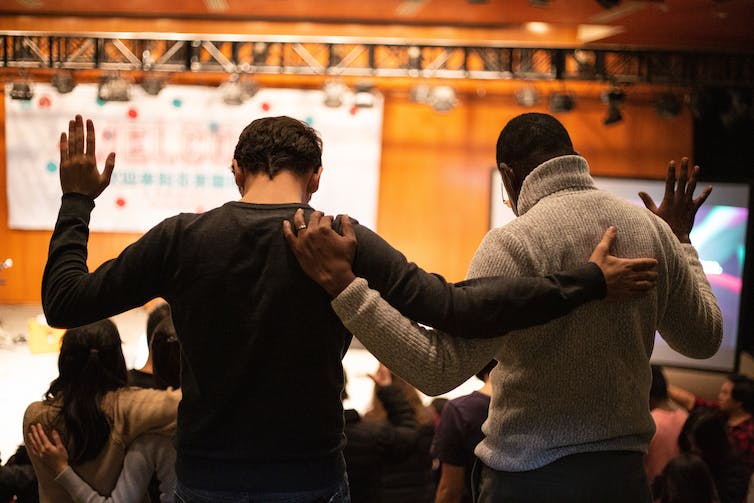Traumatic experiences are surprisingly common, with around three-quarters of the population facing some form of trauma at least once in their lifetime. It can mean experiencing things like abuse, violence, or natural disasters.
Experiencing a traumatic event alone is not enough to cause traumatic stress (a “trauma”). The person experiencing the trauma should view the event as very distressing or life threatening.
While trauma can be incredibly difficult to deal with and can leave lasting scars, there’s another side to the story: post-traumatic growth.
Post-traumatic growth is the positive psychological change that can occur in response to a traumatic event. It is often confused with resilience, which means bouncing back to the baseline after adversity. Post-traumatic growth, on the other hand, refers to an improvement in your life or outlook.
Read more: More than half of Australians will experience trauma, most before they turn 17. We need to talk about it
What does this growth look like?
People who have experienced post-traumatic growth describe a greater appreciation for life, increased personal strength, deeper relationships, a greater sense of spirituality or meaning, or a new sense of possibility for the future .
Someone who has experienced a traumatic event may decide, for example, to change careers or take up a new hobby. Some people report wanting to give back to the community or others in need after experiencing situations where they needed help after a trauma. Or they may begin to prioritize their relationships or focus on personal growth and self-improvement.
While post-traumatic growth can be a powerful force for positive change, it’s not guaranteed. About one in two people who experience trauma will experience post-traumatic growth. Younger people and those who have recently experienced trauma are more likely to have post-traumatic growth.
Our research has found some common elements that make a person more likely to experience post-traumatic growth, regardless of the type of trauma suffered.
1. Strong social supports
The most important factor promoting post-traumatic growth is the support of friends, family and those around you after experiencing a traumatic event. Seeking and accepting social support is crucial, and it can be helpful to reach out to people who have experienced similar trauma through things like support groups.
Unsplash/Kulli Kittus
Research shows that the quality of social support is also important. People report greater post-traumatic growth if the support they receive comes from people they trust.
Social support is so crucial that some therapeutic interventions have focused on using social networks to enhance the recovery of people who have experienced trauma. For example, some post-traumatic stress disorder (PTSD) recovery programs include support groups to help people heal.
Read more: Explained: what is post-traumatic stress disorder?
2. Coping Skills
Coping strategies such as humor, acceptance, and focus on the future are effective in reducing our distress after trauma, and they increase the likelihood that we will heal and find positive aspects in our experiences.
People who experience post-traumatic growth often say they have a greater sense of inner strength and feel better equipped to handle stress and difficulties in the future. These types of coping strategies are sometimes inherent, but often they can also be improved through therapy.
3. Personality traits
People who tend to be optimistic are more likely to experience post-traumatic growth. Instead of seeing the traumatic event as purely negative, optimistic people are able to find positive aspects of their experience.
This can be difficult, as traumatic experiences often involve loss, pain, and suffering. However, by finding meaning and purpose in the experience – for example, by sharing their story with others going through similar experiences – people can begin to see themselves and the world in a new light.
Again, this is sometimes inherent, but can be improved by engaging with a mental health professional.
Read more: For people with chronic pain, flexibility and persistence can protect well-being
Some studies have also shown that being more outgoing can help people experience post-traumatic growth. This may be because extroverted people are more likely to seek out social support as they tend to find themselves in more social situations.
4. Religion or spirituality
Religion often teaches that transformation and power can arise in the face of suffering.
Research shows that religious (or spiritual) people often experience post-traumatic growth because they have a greater sense of community, pastoral support, and a higher meaning behind difficulties.

Sam Balye/Unsplash
Treatment also prioritizes the same factors
The ways people thrive after adversity have helped inform researchers and clinicians about the best ways to treat post-traumatic stress.
Social support, helpful coping, and meaning-making are essential components of therapies commonly used by people who have experienced adversity, such as trauma-focused cognitive behavioral therapy, family therapy, and relationship therapy. trauma-based acceptance and engagement.
Of course, post-traumatic growth is only part of the story, and it’s an ongoing process. Trauma affects people in different ways. Sometimes healing from trauma or post-traumatic growth can be linked to factors beyond a person’s control, such as their resources or socioeconomic status.
There is no guarantee that a person will experience growth after trauma, but factors such as social support, helpful coping, personality traits, and the search for meaning make it more likely.
Read more: “The reporting process was more traumatic than the assault itself”: LGBTQ+ survivors on accessing help after sexual violence

